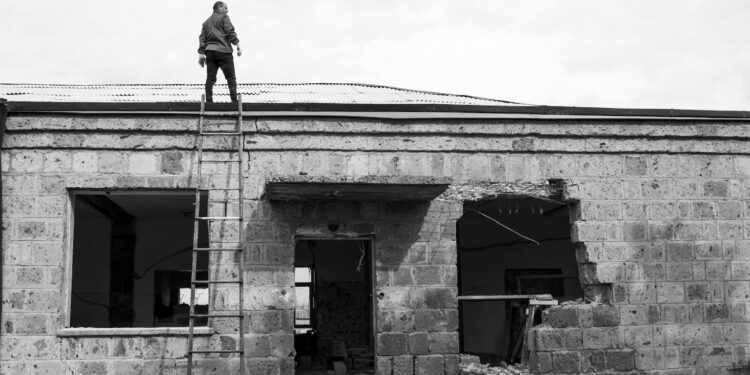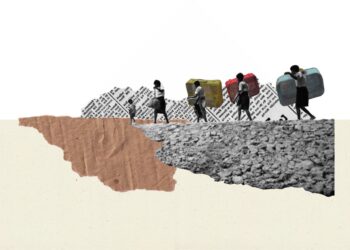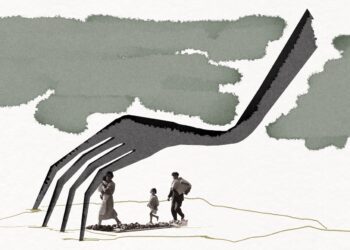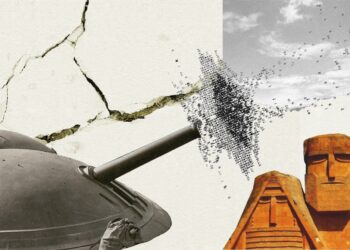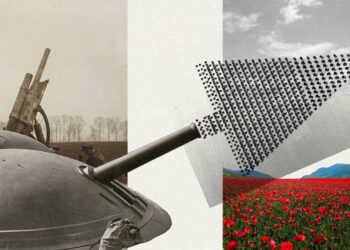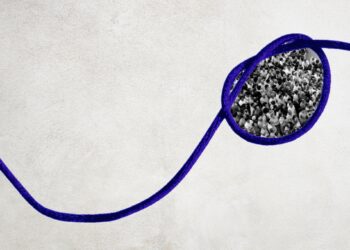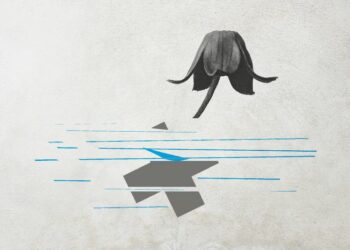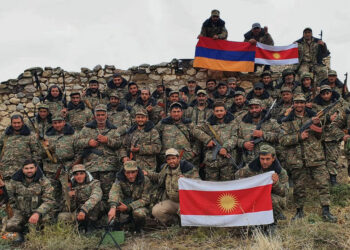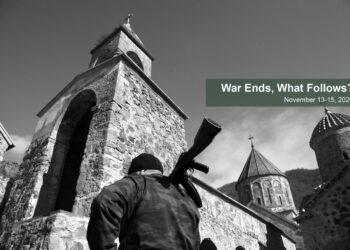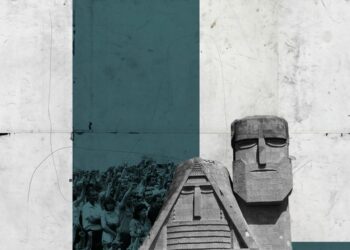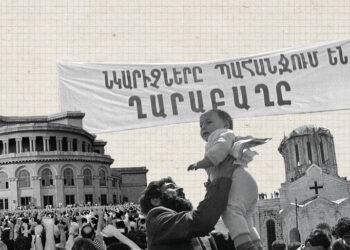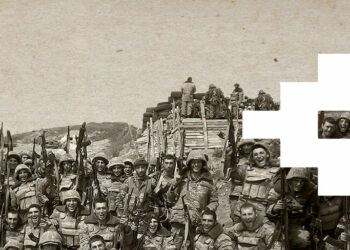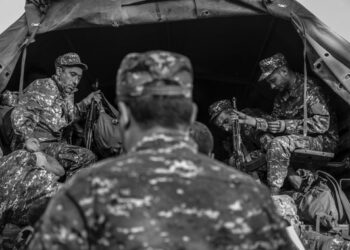Spotlight Artsakh
The Bread of the Blockade
The families forcibly displaced from Artsakh will long remember the lack of bread during the months of blockade. That bread, often moist and bitter, has become a symbol of their struggles, deprivation, courage and strength. Photojournalist Ani Gevorgyan captures the images and feelings.
Monologues: The Homes They Lost in Artsakh
“The story of the house began with a smile and ended with tears,” writes Yan Shenkman, a Russian journalist, who moved to Armenia after the war in Ukraine started. He compiled monologues from the Armenians of Nagorno-Karabakh for an upcoming exhibition about the homes they lost.
Giving Birth in the Clutches of Blockade and Displacement
During the ten-month blockade of Artsakh, hundreds of pregnant women endured fear and deprivation instead of experiencing the joy of approaching motherhood. Photojournalist Ani Gevorgyan chronicles their challenges.
We’re Home, And Yet We’re Not
In September, two families-in-law from Artsakh found refuge in the village of Yeghvard, Armenia, joining over 100,000 displaced Armenians facing similar challenges. Marut Vanyan, a journalist from Artsakh, provides insight into their experiences.
From Vayk’s Registration Center in Search of Aida
Irina Merdinyan traveled into the heart of a tragedy to help the forcibly displaced Armenians of Artsakh. In the midst of that experience, she was confronted with pain, confusion, anger and fleeting moments of joy.
The Storks of Ranchpar
Several hundred forcibly displaced people from Artsakh have found refuge in the Armenian village of Ranchpar. As they struggle to make sense of their loss and create a new life, they hang on to the hope that, like the storks of the village who return each year, they too will one day return to their native Artsakh.
Health, Women and War
With women and girls making up over half of the displaced people from Artsakh, what kinds of health and safety risks are they facing, and who is there to help?
So That in the End, Good Triumphs Over Evil…
Specialists from the Ministry of Internal Affairs are working to alleviate the anxiety of the forcibly displaced children from Artsakh by offering psychological first aid. Their journey is captured in this photo story by Ani Gevorgyan.
The Love on the Other Side of the Border: The Volunteers
As the ethnically cleansed Armenians of Artsakh streamed into Goris, they were met with hundreds of volunteers, among them diasporan Armenians, many of whom now feel a deeper connection and a stronger sense of purpose.
Armenians of Artsakh: Aching for Home
As the forcibly displaced Armenians of Artsakh struggle to comprehend the magnitude of their loss, memories of the homes and lives they were forced to leave behind suffocate them. Theirs is a story of being ripped from their roots, of pain and dispossession.
In Search of a New Home: Zorak
More than 500 forcibly displaced Armenians from Artsakh are now in the village of Zorak in Armenia’s Ararat region, where several families are living together in one house, some even in their trucks. Photojournalist Ani Gevorgyan tells their story.
An Uncertain Future, Uncertain Status
Over 100,000 forcibly displaced Armenians of Artsakh are now in Armenia facing the crippling challenge of starting over after losing everything. They also face an uncertain future with regard to their status.
Education Second, Life First
Mellisa, a six-year-old from the village of Harav in besieged Artsakh, should have started first grade this year. However, she will not be attending school, and neither will her four older siblings.
From Sri Lanka to Artsakh: Human Stories of Blockade
If they had survived it, and done so with grace and empathy, then what is to prevent us from doing the same, writes Shoushan Keshishian, about Vasuki, a survivor of the blockade of Jaffna, Sri Lanka.
From Karabakh to Artsakh: More Than a Disputed Territory
A young woman’s story of discovery, memory, loss and pain about a war that ripped apart the nation, but who comes to the realization that while Karabakh may have died on the battlefield, Artsakh, despite it all, is still alive.
Rapid Needs Assessment in Artsakh: Letting the Numbers Tell the Story
The data collected by the Rapid Needs Assessment survey, conducted by Hub Artsakh, tells a harrowing story of increasing food insecurity and deteriorating emotional and physical wellbeing. If the blockade is not lifted, the result will be catastrophic.
Artsakh: Not Only a Humanitarian Catastrophe
Nothing in Artsakh is what it used to be. The Stepanakert market, once known as a feast of tastes and colors has now become a concentrated mosaic of all our misery, writes Tamara Grigoryan, a resident of the capital city.
Deliberate Starvation of Nagorno-Karabakh Armenians
After months of gradually deepening the blockade and experimenting with various methods of coercion to force Armenians out of Nagorno-Karabakh, Azerbaijan seems to have found a slow-paced but high-impact weapon – deliberate starvation.
War Was Aliyev’s Life Mission
If concrete measures, such as direct intervention, imposing sanctions on Aliyev's family, and targeting Aliyev's reputation, are not taken, international actors involved in the mediation process will ultimately share responsibility for the events unfolding in Artsakh.
When a Bad Peace Is Worse Than War
Diplomacy, or more accurately diplomatic coercion, may ultimately avoid another war, but the endgame that the mediators seem certain to impose on the Artsakh Armenians would be nothing short of a total unilateral capitulation, writes Karena Avedissian.
The Dangerous Emptiness of Hate
The persistence of the hate-induced discourses and practices in Azerbaijan before and especially after the 2020 Artsakh War is indicative of the structural role of hatred in the political order created by the Aliyev regime.
Snapshots From the Edge of Hunger
As Azerbaijan continues to tighten its noose around Artsakh, blocking all humanitarian assistance and aid from reaching the population, young people from Artsakh share pictures of their meals.
All Armenian Men in Nagorno-Karabakh Are Now Targets for Arbitrary Detention
On July 29, Azerbaijani border services kidnapped and detained an elderly man who was being transferred from Artsakh to Armenia by the ICRC for medical treatment. Baku may now target and detain every male in Nagorno-Karabakh, writes Sossi Tatikyan.
“Integration” of Nagorno-Karabakh Armenians
What are Azerbaijan’s real intentions in relation to Nagorno-Karabakh? In this in-depth analysis, Sossi Tatikyan presents a number of similar scenarios, from the evacuation of Finnish Karelia during WWII to integration as a means of subjugating the people of Artsakh.
Aliyev Organizes Media Show in Shushi
In Shushi, the Aliyev regime gathered a mix of journalists from state agencies of mostly authoritarian countries, pro-Azerbaijani analysts, and “useful idiots” for a Global Media Forum on July 21-23. Hovhannes Nazaretyan explains.
Can a Piece of Paper Bring Long-Lasting Peace?
Without a clear recognition of the reality on the ground, especially Azerbaijan's obstructionist behavior, and without substantive enforcement instruments provided by international actors, a piece of paper cannot serve as a real peace deal, Tatevik Hayrapetyan writes.
The Imperative for International Guarantees for Security and Rights in Nagorno-Karabakh
Azerbaijan’s threat of military aggression and ethnic cleansing of Nagorno-Karabakh’s indigenous Armenian population remains extremely critical. If not prevented, it will constitute another major blow to the international order.
The Human Condition: Contemplations Under Siege
Tamara Grigoryan, who lived and worked in Karvachar for a decade and who now lives in Stepanakert asks a fundamental question: Are we going to live in Artsakh as the owners of the homeland or not?
Calling a Spade a Spade: The ICJ Orders Azerbaijan to Lift Its Blockade
On February 22, 2023, by a near unanimous vote, the International Court of Justice ordered Azerbaijan to ensure free movement of persons, cargo and other goods along the Lachin Corridor. Sheila Paylan explains.
Weaponizing Energy: Nagorno-Karabakh’s Energy Supplies Under Siege
Artsakh’s entire economy is heavily dependent on Armenia, and the blockade of the Lachin Corridor has made it more vulnerable, giving Azerbaijan the ability to weaponize Artsakh’s energy supply and control over its critical infrastructure.
Responsibility to Protect and the Ongoing Blockade of Nagorno-Karabakh
Azerbaijan’s behavior meets all of the criteria that triggers the implementation of the Responsibility to Protect (R2P) principle. The international community must resolutely raise this issue in order to deter the Aliyev regime from continuing its predatory policies.
Education Under Blockade
As Azerbaijan’s blockade of the Lachin Corridor is now in its second month, all schools in Artsakh, starting from January 19, were shut down indefinitely because of the rolling electricity blackouts and shortage of natural gas supply.
Turning the Tables: The UNSC Emergency Meeting on the Blockade of Nagorno-Karabakh
The United Nations Security Council’s emergency meeting regarding the blockade of the Lachin corridor demonstrated a remarkable shift in the international community’s reaction to the Armenia-Azerbaijan and Nagorno-Karabakh conflicts.
From the Dictator’s Mouth
Statements made by Ilham Aliyev over the past two years prove that Baku will never guarantee the rights and security of the people of Artsakh, since state sponsored hate propaganda has made Azerbaijan the number one threat to the survival of the Armenians of Artsakh.
Weaponizing Blockade With the Intent to Ethnically Cleanse
By blockading the Lachin Corridor and triggering a humanitarian crisis, Azerbaijan is employing hybrid warfare tactics against the Armenians. This operation is pursuing short-, mid- and long-term objectives. Sossi Tatikyan explains.
In Nagorno-Karabakh, Upholding the Notion of Territorial Integrity Means Ethnic Cleansing for Armenians
In Nagorno-Karabakh, the consequences of upholding Azerbaijan’s territorial integrity entails the imminent threat to the indigenous Armenian population that is no different than Kosovo, Timor-Leste or South Sudan: the inevitability of ethnic cleaning and genocide.
Deconstructing the Promise and Problems of the International Criminal Court
The scope of gross human rights violations that ethnic Armenians were subjected to during and after the 2020 Artsakh War contributes to the body of empirical data that could be used if Armenia were to become a party to the Rome Statute.
The People of Artsakh: Resilience and Anguish
A young Armenian woman, born and raised in Stepanakert, the capital of Artsakh, reflects on the changing, contradictory reality of her hometown two years after Azerbaijan launched a devastating war.
Listen to the Words of Dictators, Don’t Say We Didn’t Tell You
No analysis, no commentary, just facts: How Azerbaijan’s President Ilham Aliyev ideologically prepared Azerbaijani society for war not only against Artsakh (Nagorno-Karabakh), but also Armenia-proper.
Azerbaijan’s War of Narratives Against Armenians, Part II
Baku’s aggressive rhetoric must not be normalized. In spite of their geopolitical, oil and gas interests, major international players should define their red lines, refrain from a policy of parity and prevent further military aggression by Azerbaijan.
Azerbaijan’s War of Narratives Against Armenians, Part I
After its military victory in the 2020 Artsakh War, Azerbaijan elevated its war of narratives against Armenians to a new and increasingly aggressive level, often accompanied with disinformation.
Where Is Yerevan as Armenian Villages Handed Over?
As the Armenian villages of Aghavno, Berdzor and Sus on the Lachin Corridor were handed over to Azerbaijan on August 25, questions remain about why Yerevan was seemingly excluded from that process.
Technological Trends in the 2020 Artsakh War and the 2022 Russo-Ukrainian War
The 2020 Artsakh War and the ongoing Russo-Ukrainian war are the first classic interstate wars in almost two decades involving the regular armies on both sides of the conflict, highlighting trends in warfare, including the effect of the latest technological solutions.
Baku’s Unrelenting Violations of the Tripartite Statement
Azerbaijan’s motivations, strategy, manipulation, and attempts to legitimize its every military aggression against Artsakh are gross violations of the November 9, 2020 tripartite statement that ended the 2020 Artsakh War.
Azerbaijan Violates Ceasefire, Launches Attack Against Artsakh
Two Armenian soldiers have been killed and 19 others injured after Azerbaijani Armed Forces, violating the ceasefire regime, launch an attack in Artsakh after days of mounting escalation.
Despite Everything, Artsakh Celebrates
The resilience to persevere through unspeakable trauma was embodied by the tenacity to celebrate the May 8 and 9 holidays in Artsakh with a full schedule of events.
The View From Artsakh on a Lowered Benchmark
There’s an air of restlessness in Artsakh. It derives from the uncertainty about where the Republic of Armenia stands. The feeling is that Artsakh and Armenia are on diverging paths, and a rift has appeared between their governments.
International Community Must Prevent Azerbaijan’s Creeping Ethnic Cleansing in Nagorno-Karabakh
Latest developments in Nagorno-Karabakh demonstrate Azerbaijan’s intent to ethnically cleanse the indigenous Armenian population and highlight the necessity of introducing international norms in the peacekeeping architecture there.
Azerbaijan’s Ongoing Policy of Ethnic Cleansing in Nagorno-Karabakh
Azerbaijan’s main goal is the removal of ethnic Armenians from Artsakh through the creation of conditions unfavorable for living, as well as creating an atmosphere of fear among the Armenian population.
Azerbaijan’s Gas Blockage of Artsakh Escalates to Attack on Parukh Village
After weeks of blocking gas supply to the population of Artsakh, the Azerbaijani Armed Forces launched an attack in the Askeran region, taking control of Parukh village and surrounding positions. While the international community has offered concern, sanctions are what’s needed.
How Russia Pushed For—and Achieved—a Military Presence in Artsakh
Over a year after Russian troops were deployed to Artsakh, here’s what we know about the Russian presence there, with the historical background for Moscow’s drive for boots on the ground in Artsakh.
ICJ Orders Provisional Measures for Armenia and Azerbaijan
On December 7, the International Court of Justice announced its decision regarding the request for provisional measures by Armenia and Azerbaijan, marking the next stage in the ongoing conflict between the two states.
The Aftermath
This is not a story about war. This is the story of what happens after the bullets, missiles, bombs and drones no longer fly through the autumn air. Maria Titizian recounts her journey to Artsakh last year, two days after the signing of the trilateral statement ending the war.
One Year After the Signing of the Ceasefire Statement: Serious Security Challenges Persist
A year has passed since the end of the 2020 Artsakh War. The ceasefire statement signed by the leaders of Russia, Armenia and Azerbaijan on November 9, 2020, brought a new geopolitical reality to the region.
The Guardian Women of the Front Lines
While the majority of women didn’t pick up guns to fight in the war, many used their skills to fight in their own way. On this first anniversary of the 2020 Artsakh War, Kushane Chobanyan presents the stories of six extraordinary women who were on the front lines.
Artsakh’s Cultural Heritage Under Threat
Armenian cultural, religious and historical monuments and sites currently under Azerbaijani control in the aftermath of the 2020 Artsakh War are under immediate threat of vandalism and destruction.
Arms Supplies to Armenia and Azerbaijan
For nearly three decades, Armenia and Azerbaijan have been buying large quantities of weapons from a number of countries. Hovhannes Nazaretyan presents a comprehensive list of weapons acquired by both countries since independence.
Armenia v. Azerbaijan: On the Frontlines of the Law
The military phase of the 2020 Artsakh War seems to have ended but the legal fight for restoring and upholding human rights is just beginning. Armenia’s Inter-State Application against Azerbaijan to the ECHR marks the beginning of that strategic process.
International Human Rights Organizations and Victim-Blaming
International human rights defending organizations have been speaking in a language of “neutrality” which, in the context of the war crimes committed by Azerbaijan during and after the 2020 Artsakh War, is anything but objective, writes Karena Avedissian.
Yet Beyond the Mountains, There Was War…
The Yezidis of Armenia fought alongside their Armenian comrades during the 2020 Artsakh War. One Yezidi volunteer says that “this is our country, the graves of our ancestors are here and the future of our children is here.”
Duplicating Images: Azerbaijan’s Mirror Propaganda Operation Part II
As part of its mirroring propaganda operation during the war that was intended to cloud the information landscape, Azerbaijan also systematically mirrored the Armenian side’s visuals as well.
People of War: Living With the Aftershocks
Faced with loss and uncertainty, the Armenians of Artsakh are trying to come to grips with the defeat following the war and finding a way to pick up the pieces of their shattered lives.
The Burning Homes of an Unrecognized Republic
After 44 days of reluctant and often one-sided reporting of the 2020 Artsakh War and amidst the grey horror of cluster bombed homes, the red flames of Karvajar’s houses instantly made international headlines.
Christianity in Karabakh: Azerbaijani Efforts At Rewriting History Are Not New
In the context of the Armenian-Azerbaijani conflict, the “Albanian connection” has become a politicized issue of irredentism, hijacking the rich Christian heritage of Karabakh. The roots of this historiography go back to the Soviet policy of “nativization".
Azerbaijan’s Mirror Propaganda Operation
During the Artsakh War, Azerbaijan used mirroring propaganda to try and keep the two sides on equal moral terms, creating an information fog until international journalists began arriving to the conflict zone.
Lives Undone
In Artsakh, there is a somber air of loss, uncertainty and grief. During 45 days of war, everyone and everything from soldiers to villagers, trees to structures were afflicted and irreversibly altered. A collection of images from November 12-14, a few days after the "peace" agreement.
Belarus Was Sanctioned, Why Not Azerbaijan?
Western countries imposed sanctions on Belarus’ Aleksandr Lukashenko for cracking down on democracy and attacking civilians. Ilham Aliyev has actually been more brutal but has not been penalized.
War Ends, What Follows?
In the wake of the November 10 ceasefire agreement and introduction of Russian peacekeepers to Artsakh, details of its implementation are still being discussed. Meanwhile, opposition party leaders were arrested for allegedly planning Pashinyan’s assassination.
War Ends, What Follows? Live Updates
OSCE Minsk Group Co-Chairmanship format to remain unchanged. Protests continue in Yerevan. Pashinyan meets with President and parliamentary caucus.
Despair, Anger or Resolve
Resolve is different from blind faith that “this too shall pass.” We need the entire Armenian nation to start getting ready for the next encounter, writes Raffi Kassarjian.
War Ends, What Follows? Live Updates
As Armenians are trying to come to terms with the imposed peace deal following the Artsakh War, thousands of people took to the streets in Yerevan demanding the resignation of Prime Minister Nikol Pashinyan and his government.
War Ends, What Follows? Live Updates
The country is shaken after crushing terms were imposed to end the 2020 Artsakh War. As government buildings were vandalized overnight, attention has shifted to Yerevan. Updates to be provided as they develop.
Updates From Artsakh: Fighting on Several Fronts
As fierce battles for the defense of Shushi continue, a number of opposition forces demand the resignation of the Prime Minister and the government; a Russian military helicopter is shot down by Azerbaijani forces from the exclave of Nakhichevan.
Updates From Artsakh: The Battle for Shushi
Armenian forces were able to hold the strategic and symbolic city of Shushi even as Azerbaijani forces brought in additional reinforcements. The battle for the fortress town continues to be bloody.
The Responsibility to Protect
The ongoing war in Artsakh has profoundly impacted the Armenian world. Photojournalist Eric Grigorian's photo essay reflects on those who have had to bear the heavy human toll in protecting and safeguarding the homeland. Images are from Artsakh, Goris and Yerevan, taken between October 24 and November 5, 2020.
Updates From Artsakh: All Eyes On Shushi
Intense battles have been taking place around Shushi. Azerbaijani forces were able to advance closer to the city today. According to the Defense Ministry, Azerbaijan is putting all of its power into capturing the symbolic fortress town.
Artsakh Refugees Dream of Home as War Rages On
It had been almost two decades since Gohar Karapetyan last made the trip from Artsakh to Yerevan when she decided, on the morning of October 1, to repeat the journey, this time to escape a raging war.
Updates From Artsakh: The Defense of Shushi
Armenia’s Defense Ministry says that, after intense battles, the defense of Shushi has been successful. After heavy bombing the night before, an elderly woman and her two grandchildren were killed. Here is a chronology of official updates.
The 2020 Artsakh War: One Stepanakert Family’s Story
Statistics about numbers of civilians and young conscripts killed in conflict often water down the true magnitude of human loss. This is the story of one family’s struggle through the 2020 Artsakh War.
Updates From Artsakh: 40 Days
The Artsakh War has entered its 40th day. More than 1100 Armenian servicemen and 50 civilians have been killed. As Azerbaijani forces attempt to reach Shushi, the President of Artsakh says that everything is being done to ensure the town remains impregnable.
Updates from Artsakh: ECHR Anniversary
While today marks the 70th anniversary of the signature of the European Convention on Human Rights, civilian settlements in Artsakh continue to be targeted by Azerbaijani forces resulting in civilian casualties and damage to vital civilian infrastructure.
Failure to Prevent and Protect
In Stepanakert, EVN Report spoke with Artsakh's Ombudsman Artak Beglaryan about the political decisions of the international community and the reasons for the artificial parity in their vocabulary, their failure to realize that authoritarian regimes do not understand the language of statements but that of action and their failure to prevent, followed by their failure to protect.
Updates From Artsakh: Azerbaijani Smokescreen Fails
Stepanakert and Shushi came under shelling again this evening; Azerbaijani forces have started using banned incendiary cluster munitions; Lavrov says external players must use their powers to prevent mercenaries being sent to the Nagorno-Karabakh region. A chronology of official updates.
The Refugees: A Family of Strangers
As the war rages on, almost 80,000 Armenians from Artsakh have fled their native towns and cities and found refuge throughout Armenia proper. While they are grateful for the care they are receiving, their dream is to go back home.
Updates From Artsakh: Forests Burning
Forests in almost all the regions of Artsakh are burning because of incendiary munitions; Azerbaijani forces attempt a large-scale offensive in the northwestern direction of the front line; Artsakh’s Deputy Minister of Defense is killed in battle. Here is a chronology of official updates.
Updates From Artsakh: Disturbing Revelations
A second jihadist mercenary is captured by the Artsakh Defense Army, who admits to being offered a $2000/month salary, plus a bonus of $100 for each beheading. Here is a chronology of official updates.
Updates From Artsakh: A New Low
Despite international calls, mediation efforts and urgent appeals to cease fire, the war in Artsakh continues unabated. There is evidence that Azerbaijani forces used phosphorus munitions signaling a new low in the hostilities. Here is a chronology of official updates.
Updates From Artsakh: Scandinavian Peacekeepers or Russian Boots on the Ground?
As Foreign Ministers of Armenia and Azerbaijan met in Geneva for mediated talks, Azerbaijani forces continued to shell peaceful settlements in Artsakh and Armenia. U.S. National Security Advisor says any Turkish mediation is a non-starter, suggests Scandinavian peacekeepers be deployed.
Updates From Artsakh: ICRC Facilitates First Exchange of Bodies
A meeting of the Foreign Ministers of Armenia and Azerbaijan is expected to take place in Geneva tomorrow; Stepanakert and other towns and villages continue to come under constant shelling by Azerbaijani forces. Here is a chronology of official updates.
Primer: 15 Questions and Answers About the Karabakh Conflict
This primer provides the reader with an overview of the historical origins of the Karabakh conflict, the Soviet era, the war, the peace process all the way to the Four Day War in April 2016.
Updates From Artsakh: Maternity Hospital Bombed
Stepanakert, the capital of Artsakh and the town of Shushi came under intensive shelling today by Azerbaijani forces. A maternity hospital in Stepanakert and other civilian infrastructure were heavily damaged resulting in casualties. Here is a chronology of official updates.
Updates From Artsakh: Thirty Days of War
A month has passed since Azerbaijani Armed Forces launched a large-scale attack on Artsakh. To date, over 1000 Armenian servicemen have been killed, countless wounded while civilian settlements continue to be bombarded. Here is a chronology of official updates.
Updates From Artsakh: Ceasefire Collapses, Again
The U.S.-brokered humanitarian ceasefire that was to come into force at 8 a.m. local time on October 26 has not held. As battles continued, Artsrun Hovhannisyan admitted that Azerbaijani forces are at the gates of Armenia’s Syunik region, but said the situation is not dire. Here is a chronology of official updates.
Updates From Artsakh: A Third Ceasefire
Armenia and Azerbaijan have agreed to yet another humanitarian ceasefire in Artsakh/Nagorno-Karabakh that will come into effect at 8 a.m. local time on October 26, 2020. Here is a chronology of official updates.
The UN, International Organizations and States Are Obligated to Provide Humanitarian Aid to Nagorno Karabakh: Here Is Why
The humanitarian emergency in the Republic of Nagorno Karabakh requires the engagement of humanitarian and donor organizations, without regard to its international recognition, its present or future status.
Updates From Artsakh: Civilians at Risk
While Azerbaijani forces continue to target peaceful settlements, Artsakh’s Ombudsman said civilians in Artsakh are at high risk as Azerbaijani subversive units move into civilian settlements and pull back. There are a number of civilians missing. Here is a chronology of official updates.
Updates From Artsakh: A Battle of Survival
As Armenian and Azerbaijani forces continue to pummel one another, battle lines across Artsakh are being drawn, erased and redrawn. Diplomacy, at least for the time being, has broken down and the future remains uncertain. Here is a chronology of official updates.
War, Nothing But War: The Virtue of Brute Force and the Shortcomings of Diplomacy
The narrow geopolitical framework of the three-decade-old Karabakh conflict is now threatening to become a Eurasian nightmare: Turkey's involvement has sensationalized the war, Iran’s unease has reinforced the confusion, while Russia's perceived passiveness has created much regional anxiety.
Updates From Artsakh: COVID Becomes New Front Line Battle
As intense military operations continue in Artsakh, the number of COVID-19 cases in Armenia has skyrocketed. Healthcare officials warn that with the number of wounded soldiers requiring medical care, if people don’t start following the anti-epidemic guidelines, the healthcare system could collapse.
The Mixed Messaging of Ilham Aliyev
Armenophobic comments from Azerbaijani’s President are nothing new. He has long drummed up support among his population by promoting hatred against Armenians and using dehumanizing language, often referring to them as dogs and vermin.
Remedial Rights in International Law and Their Relevance to Artsakh
In light of the existential threat, high probability of ethnic cleansing and the already imminent humanitarian crisis in Artsakh, the international community has an obligation to grant remedial recognition to Artsakh.
Updates From Artsakh: Breakdown of Diplomacy?
Armenian PM Nikol Pashinyan said hope for a diplomatic solution is not viable at this stage as Azerbaijan is refusing to compromise. In fact, he said that Baku will not agree to anything less than the capitulation of Karabakh. Here is a chronology of official updates.
Updates From Artsakh: Shifting Contact Lines
As the death toll mounts for both sides in the war, contact lines are constantly shifting as pitched battles are taking place, primarily in the south of Artsakh; some legislators in France and the U.S. are calling for the recognition of the Republic of Artsakh. Here is a chronology of official updates.
Updates From Artsakh: Leaders of Armenia and Azerbaijan Agree to Meet
As PM Nikol Pashinyan and President Ilham Aliyev express willingness to meet in Moscow to discuss the ongoing war in Artsakh, the foreign ministers of the two countries are set to meet with U.S. Secretary of State Mike Pompeo in Washington, D.C. this Friday. Here is a chronology of official updates.
The Women of Artsakh: Our Children Are Being Deprived of the Right to Life
Fleeing the war, the women of Artsakh -- mothers, daughters, sisters and wives -- held a rally in front of the UN building in Yerevan asking for one simple thing, the right to live in peace.
Updates From Artsakh: A Broken Truce
A second attempt at a cessation of fire for humanitarian purposes failed after Azerbaijani forces began firing using artillery and small arms several minutes after the truce was supposed to come into effect. Here is a chronology of official updates.
When You Lose Your Lost Childhood Again
Journalist Lusine Musayelyan remembers the first war. She remembers Baroness Caroline Cox giving her colorful candy in crinkly paper. She remembers the bombing and the bunkers.
Updates From Artsakh: A New Attempt at a Humanitarian Truce
Following a day that saw Azerbaijani drones being shot down over Armenian airspace, Stepanakert coming under heavy shelling and the Azerbaijani city of Ganja being hit, a humanitarian truce was announced. Here is a chronology of official updates.
Updates From Artsakh: 20th Day
As the number of casualties, both military and civilian, increases intense battles continue in Artsakh. The war, now in its 20th day, continues to rage. Here is a chronology of official updates.
A Record of War
Photojournalist Eric Grigorian captures the devastation of war, its destruction of lives, heritage sites and schools. A portrait of a nation at war, of a capital where the elderly and the grieving live underground.
Updates From Artsakh: Human Rights and the Unrecognized Children of Artsakh
The children of Artsakh are enduring displacement, loss and trauma. While Artsakh is not a recognized state, the children of Artsakh have a right to be recognized, protected and cared for. As the war rages, the human cost will be unbearable. Here is a chronology of official updates.
Updates From Artsakh: A Solitary Battle Against Terrorism and Aggression
As Azerbaijani forces intensified their operations along the front line Artsakh President of Arayik Harutyunyan and Prime Minister of Armenia Nikol Pashinyan of Armenia addressed the nation. Here is a chronology of official updates.
When the Only Imperative Is to Live
The war has infiltrated almost every Armenian home. While soldiers are fighting on the front, a new generation of children and their families who escaped this new war in Artsakh are looking for ways to cope with the new trauma.
Updates From Artsakh: The Battle for Peace
As one of the most intense battles since the start of the war took place today, Artsakh’s President called for the participation of every Armenian to ensure future generations live in peace, while Armenia’s Foreign Affairs Minister met with the OSCE Minsk Group Co-Chairs. Here is a chronology of official updates.
Updates From Artsakh: An Existential Threat
As the Foreign Affairs Ministers of Armenia and Russia met in Moscow to discuss the situation in the Nagorno-Karabakh conflict zone, intense battles continued in the southern direction of the frontline. Here is a chronology of official updates.
Updates From Artsakh: Humanitarian Ceasefire Falls Apart
Artsakh’s president says that if Azerbaijan does not show willingness to find a peaceful solution to the conflict in the next two days, he will request that Armenia and other countries formally recognize the independence of the Republic of Artsakh. Here is a chronology of official updates.
The Responsibility to Protect, Remedial Secession and Nagorno-Karabakh
Does the armed conflict of international character waged by Azerbaijan and Turkey against Armenia and Nagorno-Karabakh warrant an international recognition of Artsakh’s remedial secession?
Updates From Artsakh: A Fragile Humanitarian Ceasefire
After almost two weeks of bloody battles in Artsakh, a humanitarian ceasefire was brokered in Moscow. As the deadline approached, Azerbaijani intensified their military operations. Here is a chronology of official updates.
Azerbaijan, Turkey Responsible for Grave Breaches of Humanitarian Law
Azerbaijan, in collaboration with Turkey is responsible for grave breaches of international humanitarian law and war crimes. The international tribunal should not turn a blind eye to the situation.
Updates From Artsakh: A Waiting Game
As the foreign ministers of Armenia, Azerbaijan and Russia meet in Moscow to try and agree on a cessation of hostilities, Azerbaijani armed forces attack Stepanakert. Here is a chronology of official updates.
The Real Perpetrator of the 2020 Artsakh War
Statements and hints by Azerbaijan about an impending war went unheeded. Why would Armenia want to halt the negotiation process to start a war? Here are some of the facts and context which demonstrate it was Azerbaijan that started the war.
Updates From Artsakh: As Battles Continue, Iconic Cathedral in Shushi Targeted
As battles continue along the Line of Contact, the Holy Savior Ghazanchetsots Church in Shushi was targeted twice today by Azerbaijani forces, considerably damaging the historic monument and wounding several foreign journalists. Here is a chronology of official updates.
Updates From Artsakh: Unrelenting Battles Continue
Now in its eleventh day, the Artsakh War is proving to be one of the fiercest, bloodiest battles the region has seen since the collapse of the Soviet Union. Here is a chronology of official updates.
Updates From Artsakh: Implications for the Wider Region
As civilian infrastructure continues to be targeted in Stepanakert, the Azerbaijani military launched another large-scale offensive in the southern direction of the Artsakh-Azerbaijan Line of Contact today. Here is a chronology of official updates.
Fighting for Existence: Armenia Battles Two Repressive Regimes and Mercenaries
Given the geography, tactics and methods of the Azerbaijani offensive, the autocratic regime of Ilham Aliyev is aiming to forcibly occupy the territory of Artsakh through committing large-scale atrocities.
Updates From Artsakh: An Unfolding Humanitarian Crisis
As fierce battles continue on the Artsakh-Azerbaijan Line of Contact, a humanitarian crisis is unfolding in Artsakh as civilians and vital infrastructure come under fire, particularly in the capital Stepanakert.
Updates From Artsakh: Scope of Military Operations Intensify
As Stepanakert came under continuous bombardment today, Armenian forces went on the counter-offensive and targeted the military airport in Ganja, Azerbaijan. Here is a chronology of official updates.
Stepanakert Under Attack
As Stepanakert, the capital of Artsakh came under continual shelling by Azerbaijani armed forces, photojournalist Eric Grigorian captured the devastating aftermath.
Updates From Artsakh: Fierce Battles Continue As Azerbaijan Launches Large-Scale Offensive
In one of the worst days of fighting on the Artsakh-Azerbaijan Line of Contact, the President of Artsakh heads to the front line with special forces and Armenia’s Prime Minister addresses the nation. Here is a chronology of official updates.
Martakert: A City Fractured
The city of Martakert in Artsakh came under heavy shelling twice since the start of the war. This photo story captures the aftermath.
Updates From Artsakh: Stepanakert Sees Heaviest Strikes To Date
After Azerbaijani armed forces launched a wide scale offensive in Artsakh, today, the capital Stepanakert came under the heaviest shelling since the end of the first Karabakh War. Here is a chronology of official updates.
Stepanakert Shelled
The capital of the Republic of Artsakh was shelled twice today by Azerbaijani armed forces injuring civilians and damaging buildings and infrastructure. Photojournalist Eric Grigorian captured these images in Stepanakert.
Updates From Artsakh: As Fighting Intensifies, Journalists Among Wounded
As battles rage along the length of the Artsakh-Azerbaijan Contact Line, a number of foreign and Armenian journalists were wounded when the city of Martuni came under Azerbaijani fire.
Updates From Artsakh: Civilians Continue to Come Under Fire
Azerbaijan continues to target civilian populations in Artsakh using combat drones and artillery strikes which have resulted in civilian casualties in Martakert. Here is a chronology of official updates.
A Home to War
These powerful images capture fragments of life in Artsakh, a place that is boundlessly resilient yet has too often become a home to war.
Updates From Artsakh: Azerbaijan Expands Offensive to Armenia
In a third day of fighting, Turkey is not hiding its direct involvement, including the use of its air force. Azerbaijan’s intense attacks against Artsakh have expanded to also include Armenia’s eastern Gegharkunik region around Lake Sevan.
Life in the Bunkers of Stepanakert
Following the attack by Azerbaijani Armed Forces on September 27, the women and children of Stepanakert shelter in bunkers while most of the men are off to the frontline.
Azerbaijan Launches Wide Scale Offensive
In the early morning hours of September 27, Azerbaijani Armed Forces launched an offensive along the Artsakh-Azerbaijan Line of Contact. We present a briefing of the situation.
The HALO Trust: Artsakh’s Guardian Angels
While Artsakh has experienced the highest per capita accident rate in the world, it has seen a ten-fold reduction in landmine accidents since The HALO Trust began demining operations in 2000.
The Artsakh Highway and the European Parliament
A recent joint statement by three Members of the European Parliament on the construction of a new, third highway between Armenia and Artsakh was not well-received in Armenian circles.
The Eastern Partnership Beyond 2020 – A View From Brussels
There is a growing view that the Eastern Partnership needs to formally move beyond its founding premise as a bridge between neighbors and to become a vehicle for significant economic integration and ultimately, perhaps, EU accession.
Europe’s Balancing Act on the Nagorno-Karabakh Conflict
The upcoming Brussels Summit on the Eastern Partnership will be another challenge for Armenia as it seeks to maintain the internationally-recognized OSCE Minsk Group framework, with its inclusion of the principle of self-determination.
Roadblocks to a Nagorno Karabakh Settlement
Russian Foreign Affairs Minister Sergey Lavrov’s recent statement regarding a step-by-step approach to resolving the Nagorno Karabakh conflict reflects Russia’s centuries-old imperial instincts of using divide-and-conquer tactics on its periphery.
The Liberation of Shushi: A Turning Point on Many Fronts
The liberation of the strategic town of Shushi was a turning point in the Karabakh war, causing a dramatic shift in the military progress of Armenian forces and ultimately obstructing future Turkish-Armenian relations.
Artsakh Presidential Race Goes to Second Round in Historically Competitive Election
Presidential and parliamentary elections were held in Artsakh (Nagorno-Karabakh) on March 31. While voter turnout was high (72.7%), no presidential candidate received the required majority of votes, necessitating a runoff election to take place in two weeks.
President Bako Sahakyan Dismisses Calls to Postpone Artsakh Election
Voters will be given masks, hand sanitizer and their own pen as the vote looks set to go ahead on March 31 as originally planned.
Music and War: Survival, Rebirth and Resilience in Artsakh
In the face of war and turmoil, music has remained one of Artsakh’s most cherished aspects of their culture. Tradition and new influences are what keep the music alive.
Infinite Hope: Artsakh Vignettes
Gayane Ghazaryan pieces together the stories, struggles and dreams of the people of Artsakh through a series of vignettes.
Football for the Forgotten States: Artsakh Prepares for the ‘Other European Cup’
For many, it might seem that Artsakh, an unrecognized state, is an unlikely place to hold an international football tournament. But that is exactly what will happen starting June 1, when Artsakh hosts the 2019 European Football Cup of the Confederation of Independent Football Associations.
Shamakhi: A Lost Dialect, a Lost Identity
Shamakhi is an Armenian dialect that is on the verge of extinction. While many Armenians from Shamakhi feel a sense of pride in their history and dialect, for the new generation who, along with the rest of the Shamakhetsis were forced to flee their village during the Karabakh War, the dialect is simply a matter of history.
Dokhtur’s Artsakh Fairytale
When the war broke out in Artsakh in the early 1990s, Aida Serobyan was a 36-year-old doctor and mother of three. She decided to volunteer for two months as a field doctor, but ended up staying for two years until the end of the war in 1994. Although she helped to heal the injured, she herself was wounded four times on the battlefield. This is her story.
Destination Hadrut: Arman in Uniform
A personal essay by Gayane Ghazaryan about a trip to Artsakh to see her brother for the first time after he left for his mandatory service in the army. A day her family had always known would come but was never fully ready for. Գայանե Ղազարյանը գրում է իր նորակոչիկ եղբորը առաջին անգամ Արցախում տեսակցության գնալու իր փորձառության մասին։ Մի օր, որին նրանք սպասել են, բայց այդպես էլ պատրաստ չեն եղել։
Land of the Ghashang People
In this moving photo essay, journalist Yelena Gevorgyan and photographer Mariam Loretsyan explore Stepanakert through their eyes and impressions, piecing together the stories that bind the Armenians of Artsakh to the land.
Returning From the Line
What is it like to find yourself on a heavily militarized contact line? How does it feel to see an adversary, a mere 400 meters away, who was the reason you became a refugee? Anna Astvatsaturian Turcotte, a refugee from Baku, writes about her emotional journey to the line and back.
1988: Thoughts Spoken Aloud
Vardges Baghryan, a journalist from Artsakh recounts his personal memories from the Karabakh Movement and the war. He recalls the siege on the village of Karintak and how the future freedom and independence of the people of Artsakh was forged.
There is Now a Statue of a Dove in Sumgait
Deciding never to use the word Genocide and then coming face-to-face with it again in a new context; between reading biographies of the victims of the Sumgait Pogrom over and over again and the urge to see who now occupies the homes of the Armenians of Baku and Sumgait, writer Lusine Hovhannesyan unexpectedly discovers a common yet obvious thread.
The Karabakh Movement or What was Happening in Soviet Armenia 30 Years Ago
Harutyun Marutyan writes that the Karabakh Movement was not only the first of the Eastern European revolutions, but it played a considerable role in the democratization of Soviet society, was pivotal in the deconstruction of the Soviet Union and consequently in the elimination of the threat of communism.
My “Karabakh Movement”
Journalist Lusine Hovhannesyan recounts her personal memories as a university student during the first days of the Karabakh Movement. She writes, “We became beautiful and fell in love easily like young men and women living out their last days at the barricades and we sang songs of resilience in the streets of Yerevan.”
How It All Began: The Soviet Nationalities Policy and the Roots of the Karabakh Problem
Long before the first rallies and clashes over the territory of Nagorno Karabakh, there were several signs of the coming storm writes Mikayel Zolyan. One of these was the “war of memory,” waged not by soldiers, but in the sphere of historiography.
1988
In this exceptionally honest and candid article, Gevorg Ter-Gabrielyan writes about his impressions from the first few months of the Karabakh Movement 30 years ago, with words he did not have nor could find at the time.
Karabakh Movement 88: A Chronology of Events on the Road to Independence
The Karabakh Movement was a crystallizing moment in the collective and historical memory of the Armenian nation. In this first in a series of articles about the Movement, EVN Report presents a chronology of the events of 1988 which eventually paved the way to independence.
Caviar: A New Narrative in Artsakh
The Republic of Artsakh (Nagorno Karabakh) is slowly trying to climb its way out of isolation and one of the ways it hopes to achieve this is to produce and export ‘black gold' to the world. EVN Report visited the sprawling caviar production facility nestled in a quiet valley in this unrecognized state often referred to simply as a ‘conflict zone.’
Propaganda and the Casualties of War
How nations in conflict deal with loss is a reflection of how they also confront issues of war and peace. In the recent escalation near the Contact Line in Karabakh (Artsakh), an Azerbaijani child was killed. Using the bloodied image of the child by Azerbaijani authorities as a tool for propaganda speaks volumes.
From Extreme Tourism to the First Pub in Stepanakert
Azat Adamyan, a young entrepreneur from Karabakh (Artsakh) created a hiking club, volunteered during the April War, opened the first-ever pub in Stepanakert and now has his sights set on bigger plans. While he realizes the limits of his reality, his dreams are boundless.
Taking Up the Challenge of Peace
Deputy Foreign Affairs Minister of Artsakh, Armine Aleksanyan on her long journey from Martouni to Stepanakert, to London and Vienna and back to Artsakh to work in the service of a country that is not recognized by the world.
Armenian Citizen in Azerbaijani Captivity
The Defense Ministry of Azerbaijan released a video on June 21 of a man they allege is a captured Armenian soldier. They claimed that the man was apprehended after an attempt by the Armenian military to infiltrate into Azerbaijani territory.
The Spirit of Artsakh
Photographer Scout Tufankjian has captured the essence of Artsakh (Nagorno Karabakh) through her photos. One year after the April War, EVN Report is proud to present these images as a reminder that all children deserve to live in peace.
A Deepening Sense of Insecurity
Vahram Ter-Matevosyan writes that it is difficult to measure just how much the average Armenian was satisfied with the explanations the government provided about the scope of casualties and destruction during the April escalation. While the government was quick to praise the heroes of the war, it failed to punish those whose task it was to ensure the army was free of corruption allegations.
War Crimes in Spring
There has been a pattern of Azerbaijani war crimes committed since the end of the Karabakh War in 1994. The Four Day War last April was no exception. EVN Report presents a detailed account of Azerbaijani war crimes in Artsakh (Nagorno Karabakh).
Nagorno Karabakh: The Four Day War
Writer and photojournalist Simone Zoppellaro writes that the moral and political responsibility of a conflict doesn’t rest solely on the actors, or those who arm them. It rests also on the nations that would have the power to intervene and stop the hostilities but prefer to keep themselves detached or indifferent.
Song Fragment for April Afternoon
Photojournalist Eric Grigorian and poet Arto Vaun collaborate in this piece that combines haunting portraits from the Four Day War last April with an evocative new poem.
Spotlight Karabakh
This special section is a historical overview of the disputed region of the Republic of Artsakh (Nagorno Karabakh Republic, NKR), one of the last unresolved conflicts in the former Soviet space.

